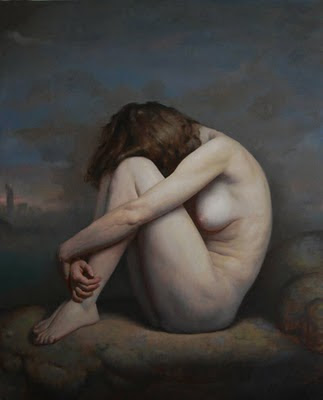But the zeitgeist is shifting. My viewpoint on the changing climate was referenced in an article by arts journalist Pat Rogers about the return of the figure, along with that of photographer / video artist Jane Martin who beautifully dissolves the nude behind screens of mist and water.
So the figure is back and she is being led by the hand into the spotlight by young artists like Adam Miller. It's happening. But what is driving it? If we want to encourage the trend it would help to know.
Business As Usual for 35,000 Years

An easy answer to the question "why now?" would be that humans are simply back to the "business as usual" which started our 35,000 years ago with the Hohle Fels Venus statuettes (Photo by H. Jensen, Universität Tübingen). According to this mode of thinking, modernism will turn out to be a brief 80 year interruption caused by the ironic joke of Duchamp, whose pranks were a necessary breath of fresh air at the time but were taken a little too far for a little too long. After all, why should today's painters pay much heed to a fellow who didn't think very highly of "ocular" art in the first place, and would rather be playing chess?
Another easy answer is that there is no art historical conflict here worth discussing, because the distinction between abstraction and representation is an artificial one that has disappeared for all practical purposes. Realist painters have internalized and co-opted the critical language, processes, narrative and concepts of modernism since Eric Fischl and Vince Desiderio made their intellectual forays in the 1980s against the "painting is dead" crowd. I don't know very many realists who claim that their job is to be a visual journalist by faithfully coping nature, yet I often hear painters talk about interpreting their authentic visual experience through the language of abstract shapes and imposing a conceptual understanding of the subject matter, whether that concept entails psychological presence, narrative, or form itself.
Both of these attitudes have a case to make, but I suspect there is a deeper cultural shift at work. Young artists are experiencing global interconnectedness via the environmental movement and issues like global climate change. They are hyper-connected in their informational nakedness on the internet, and after 8 hours a day on Facebook and in the studio craving the desire for real human connection.
The economic climate may have been the point of inflection. Since the 2008 crisis, disenchantment with market-driven value systems has positioned realism as the "blue chip value stock" of art. Skillful execution invests an object with uniqueness, irreplacability, and therefore intrinsic value that is independent of market fluctuations.
To the ears of this young 21st century audience, Picasso's statements below have a different ring to them:
"Obviously, nature exists so we may rape it"
"I too believe that everything is unknown, that everything is an enemy!"
New York: First Avon Books Printing, October 1989.
It's an adolescent and meatheaded ring, to be specific. Yet not so long ago, such sentiments were seen as the testosterone-spiked fuel of a great creative engine. Our information age has exposed utterly forgotten 19th century sensations like Meissonier, the most commercially successful artist of a half-century now ignored and unmentioned in the textbooks, so we can plausibly imagine a time 50 years from now when Picasso becomes the Meissonier (or even the Bouguereau) of the 20th century.
Our sense of beauty is what makes us human, even more so than our logical reasoning which is so easily twisted to evil ends, or recruited into the service of our emotions, or used to justify our egotistical desires.
The project of aesthetics has failed to define universal criteria for beauty, and so thinking about Beauty is now considered to be a a dead-end endeavor. Even Tolstoy threw up his hands and criticized the notion of beauty reduces to "that which I find pleasing."

But Beauty is not merely a subjective feeling; it is intricately linked to the basic fabric of the universe, as any mathematician or physicist knows. In mathematics for example we are confronted with mysterious idea of "elegance", that the most aesthetically beautiful mathematical solution is almost always the correct one. Throughout the history mathematics, the beautiful solution which displayed characteristics of simplicity, harmony and proportion yet seemed to have no practical application has proven crucial in Physics 50 or 100 years later. Mathematical ideas like the Golden Ratio (left, image by Joel Holdsworth) demonstrate how our intuitive sense of beauty has a deep kinship with the fundamental laws of nature.
A beautiful object acts as a pointer to an underlying truth that expresses a harmony with the fundamental nature of reality. Beauty defies objective categorization because it is a material object pointing to the immaterial truth. The tangible acts as a compass needle pointing to the intangible. Rather than despair over the fact that Beauty defies definition in concrete terms, it is this fluid quality of Beauty that liberates the artist. It is the role of the artist to propose a definition of Beauty in the visual language of her particular life experience.
Post-modernism has left us at a dead end: if anything can be art, then art it is nothing. This vacuum has taken the notion of the avant garde down with it as well. Today's artists are presented with a blank slate, armed with a treasure trove of digital imagery from all of history, and freed from the conformist pressure of a self-appointed avant garde.
In this liberated art historical vacuum , the current zeitgeist of connectedness has brought us right back to business as usual for humans. Here we are, still looking at each other naked, compelled to do the least necessary yet most essential activity: making Art, the inspired exercise of a craft for the purpose of intentionally transmitting, through external indications, the thoughts and emotions which the artist has experienced.





